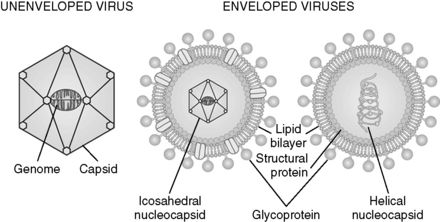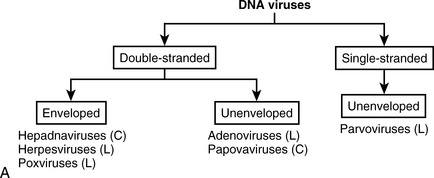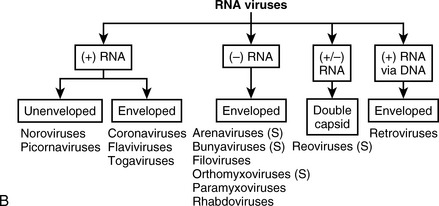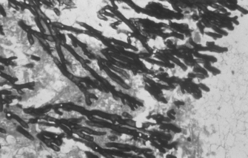Chapter 22 Viral, Parasitic, and Fungal Diseases
Insider’s Guide to Viral, Parasitic, and Fungal Diseases for the USMLE Step 1
Preparing for microbiology does not end after you master the bacterial diseases that were discussed in the previous chapter. These remaining critters are important, too. Fungi are becoming particularly high-yield on Step 1. In fact, some students report having more questions on fungi than on bacteria, so you should learn this section particularly well. Viruses and protists also show up rather frequently on boards, though not nearly as often as do bacteria and fungi. In comparison, helminths and helminth-related drugs are a relatively low-yield topic. We recommend that you study for this section in the same way that you learned the bacteria in Chapter 21.
Basic concepts in virology
1 What structural components are used to categorize viruses?
Viruses can be classified according to the following:
All DNA viruses except the Parvoviridae family contain dsDNA. All are enveloped except Parvoviridae, Adenoviridae, and Papovaviridae. If you can memorize the viruses that are all medically relevant DNA viruses, then you know by default any other virus must contain RNA (Figs. 22-1 and 22-2).

Figure 22-2 Virion structures.
(From Rosenthal K, Tan J: Rapid Review Microbiology and Immunology. Philadelphia, Mosby, 2007.)
2 Name the disease associated with each DNA virus listed in Table 22-1.
| Family | Member Virus(es) | Disease(s) |
|---|---|---|
| Parvoviridae | Parvovirus B19 | Fifth disease, aplastic anemia, arthritis, hydrops fetalis in utero |
| Herpesviridae | Herpes simplex virus types 1 and 2 (HSV1 and HSV2) | Oral and genital lesions Temporal lobe encephalitis |
| Varicella-zoster virus (VZV) | Chickenpox (varicella), herpes zoster | |
| Epstein-Barr virus (EBV) | Infectious mononucleosis | |
| Cytomegalovirus (CMV) | CMV retinitis, congenital deafness | |
| Human herpesvirus types 6 and 7 (HHV6 and HHV7) | Roseola infantum (exanthema subitum) | |
| HHV8 | Kaposi sarcoma in HIV infection | |
| Poxviridae | Variola | Smallpox |
| Molluscum contagiosum virus | Umbilicated papules (spread among wrestlers and sexual partners) | |
| Hepadnaviridae | Hepatitis B | Hepatitis |
| Adenoviridae | Adenovirus | Conjunctivitis, pneumonia, gastroenteritis and pharyngitis |
| Papovaviridae | Human papillomavirus (HPV) | Serotypes 16, 18 cause cervical dysplasia |
| JC virus | Progressive multifocal leukoencephalopathy |
HIV, human immunodeficiency virus.
3 Cover the right-hand column in Table 22-2, and using the clinical description given, name the most likely virus.
Table 22-2 Classic Clinical Manifestations of Infection with Different Viruses
| Description | Virus(es) |
|---|---|
| Rash with “slapped cheek” appearance | Parvovirus B19 |
| Descending maculopapular rash, Koplik’s spots | Measles (rubeola) virus |
| Typically causes gastroenteritis but may cause paralysis by destruction of anterior horn cells | Poliovirus |
| Cervical cancer in sexually active smoker | HPV (serotypes 16,18) |
| Parotitis, orchitis, and possible sterility in males | Mumps virus |
| Cataracts leading to blindness in newborns | Rubella virus |
| Painful vesicular lesions in dermatomal pattern; virus remains dormant in dorsal root ganglion | Varicella-zoster virus |
| Acute retinitis in patient with AIDS | CMV |
| Genital warts | HPV (serotypes 6, 11) |
| Painful genital vesicular lesions | HSV2 (occasionally HSV1) |
| Hepatitis in pregnant women, with high mortality rate | Hepatitis E virus |
| Fatigue, splenomegaly, and atypical lymphocytosis in a teenager; positive heterophile antibody test result | Epstein-Barr virus (EBV) |
| Gastroenteritis on cruise ship | Norwalk virus |
| Common cause of gastroenteritis in children | Rotavirus |
| Common cold viruses | Coronaviruses, rhinoviruses |
| Most common cause of bronchiolitis in children | RSV |
| Segmented genome can undergo reassortment, causing epidemic shift pneumonia | Influenza A virus |
| Severe encephalitis after an animal bite; intracytoplasmic Negri bodies in neurons | Rabies virus |
| Neonatal encephalitis | HSV or CMV |
AIDS, acquired immunodeficiency syndrome; CMV, cytomegalovirus; HPV, human papillomavirus; HSV, herpes simplex virus; RSV, respiratory syncytial virus.
Basic concepts in parasitology
1 What are protozoa?
Parasites can be classified as protozoa or metazoa. Protozoa are single-celled eukaryotic organisms. The medically important protozoa and their associated diseases are listed in Table 22-3.
Table 22-3 Protozoa Commonly Causing Disease in Humans
| Protozoan | Associated Disease |
|---|---|
| Entamoeba histolytica | Amebic dysentery (may cause sterile, “flask-shaped” liver abscess) |
| Giardia lamblia | Giardiasis (foul-smelling diarrhea after drinking contaminated water) |
| Cryptosporidium spp. | Diarrhea in immunocompromised person |
| Trichomonas vaginalis | Trichomoniasis (vaginitis with green discharge) |
| Plasmodium falciparum, Plasmodium vivax, Plasmodium ovale, Plasmodium malariae | Malaria; spread by Anopheles mosquito (only P. vivax and P. ovale cause recurrent infection due to liver hypnozoite stage) Treat with primaquine to eradicate; adverse reaction in patients with G6PD deficiency is hemolytic anemia |
| Toxoplasma gondii | Toxoplasmosis (from cat feces) Can cause intracerebral infection in HIV infection |
| Leishmania spp. | Leismaniasis (cutaneous and visceral) |
| Trypanosoma brucei | African sleeping sickness (African trypanosomiasis) Transmitted by tsetse fly |
| Trypanosoma cruzi | Chagas disease (American trypanosomiasis), reduviid kissing bug Dilated cardiomyopathy, dementia, and megacolon |
G6PD, glucose-6-phosphate dehydrogenase; HIV, human immunodeficiency virus.
3 Cover the left column in Table 22-4, and from the description of the infection at the right, name the helminth that causes it.
Table 22-4 Helminths Commonly Causing Disease in Humans
| Helminth | Manifestation(s)/Mechanism(s) of Infection |
|---|---|
| Cestodes (Flatworms) | |
| Taenia solium (pork tapeworm) | Infection from eating pork leads to intestinal worm; infection from egg ingestion causes cysts to encrust in brain |
| Taenia saginatum (beef tapeworm) | Transmitted by undercooked beef (mostly asymptomatic) |
| Diphyllobothrium latum (fish tapeworm) | Extremely long intestinal tapeworm that causes vitamin B12 deficiency and anemia; can be acquired by eating raw fish |
| Echinococcus granulosus | Ingestion of eggs in dog feces, causing cysts in liver, lungs, and brain Rupture of cysts causes allergic reaction |
| Nematodes (Roundworms) | |
| Enterobius vermicularis (pinworm) | Anal itching with white worms visible in perianal region; positive result on Scotch tape test |
| Ascaris lumbricoides (giant roundworm) | Intestinal infection, but worms pass from intestine to lungs Marked eosinophilia Eggs have rough, bumpy surface |
| Ancylostoma duodenale or Necator americanus (hookworms) | Larvae directly penetrate the skin and attach to intestinal mucosa, causing chronic blood loss and anemia |
| Trematodes (Flukes) | |
| Schistosoma hematobium | Hematuria after swimming in the Nile Egg has small terminal spine Increased risk of bladder squamous cell cancer |
| Schistosoma mansoni or Schistosoma japonicum | Free-swimming cercariae released from snails infect the human host Eggs are antigenic and induce granuloma formation Pipestem fibrosis of liver |
| Clonorchis sinensis | Biliary obstruction in patient from southeast Asia |
| Paragonimus westermani | Transmitted by eating raw crab meat, resulting in gastrointestinal and pulmonary disease |
Basic concepts in mycology
1 What are the two morphologic types of pathogenic fungi?
Filamentous mold and unicellular yeast are the two morphologic types. An example of a filamentous mold is Aspergillus. Inhalation of spores, often found in hay and dead organic matter, is responsible for allergic bronchopulmonary aspergillosis, angioinvasive aspergillosis, and pneumonia with “fungus balls.” The pathognomonic microscopic appearance of Aspergillus is septate hyphae with a 45-degree branching pattern (Fig. 22-3). Other pathogenic filamentous molds include Mucor and Rhizopus, which branch at wide angles.
Stay updated, free articles. Join our Telegram channel

Full access? Get Clinical Tree












